Complete Solutions to Exercises of chapter NEWTON'S LAWS OF MOTION of Class 11 book with complete answers and questions
| Class 11 | PHYSICS |
| Chapter | NEWTON'S LAWS OF MOTION |
| HC VERMA | Exercises |
| Number Of Questions | 42 |
| Academic Year | 2023-24 |
A block of mass 2 kg placed on a long frictionless horizontal table is pulled horizontally by a constant foerce F. It is found to move 10 m in the first two seconds. Find the magnitude of F.
View SolutionA car moving at 40 km/h is tobe stopped by applyin brakes in the next 4.0 m. If the car weighs 2000 kg, what average force must be applied on it?
View SolutionIn a TV pictgure tubeelectrons re ejected from the cathode with negligible speed and reach a velocity of `5x10^6` m/s in travelling one centimeter. Assuming straight line motion, find the constant force exerted on the electron. The mass of the electron is `9.1xx10^-31` kg.
View SolutionA block of mass 0.2 kg is suspended from the ceiling by a light string. A second block of mass 0.3 kg is suspended from the first block through another string. Find the tensions in the two strings. Take `g=10 m/s^2`.
View SolutionTwo blocks o equal mass m are tied to each other through light string. One of the blocks is pulled along the line joining them with a constnt force F. Find the tension in the string joining the blocks.
View SolutionA paticle of mass 50 g moves on a straight line. The vatiation of speed with time is shown in figure. Find the force acting on the particle at t=2,4 and 6 secons.
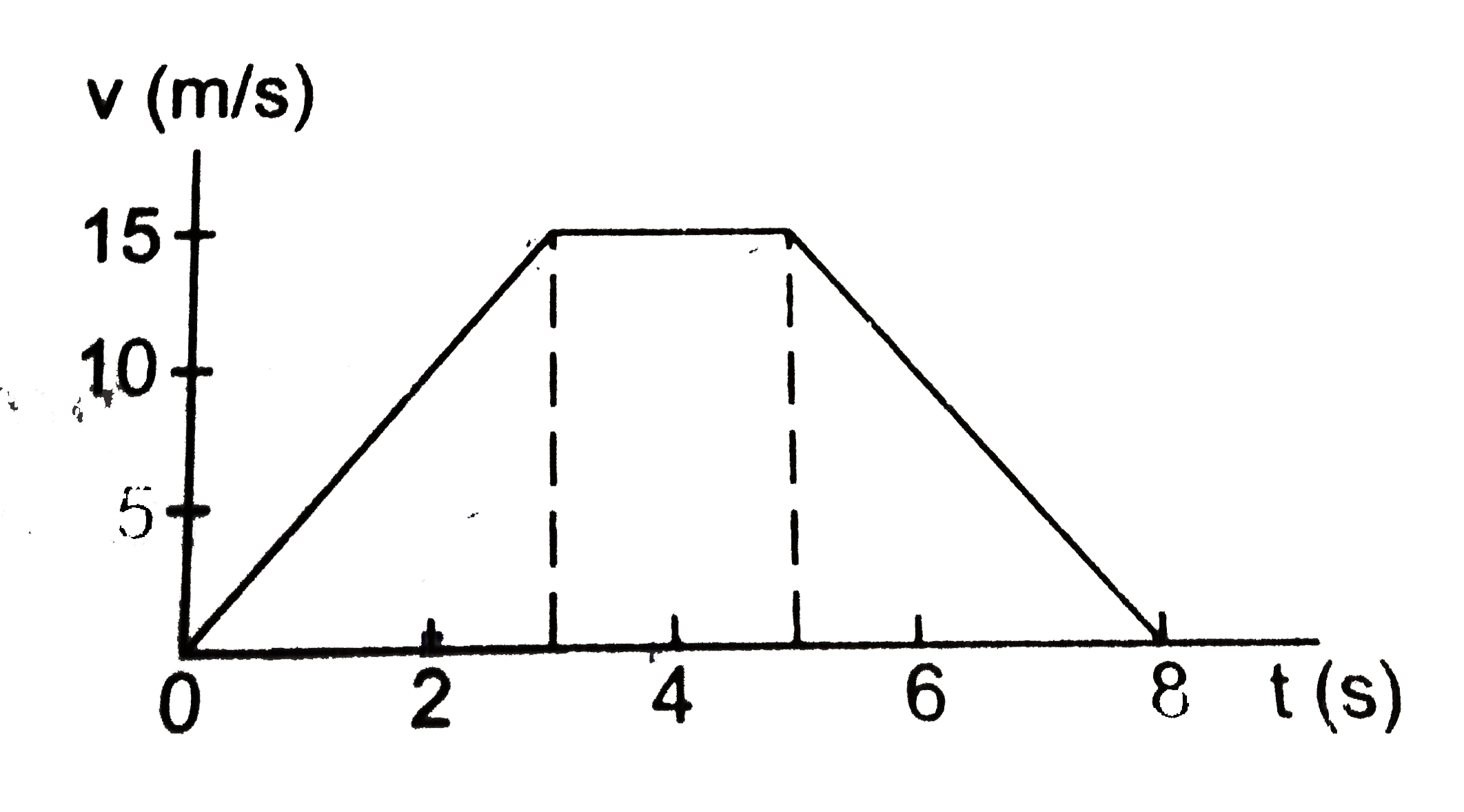
View SolutionTwo blocks A and B of mass `m_A and m_B` respectively are kept in contact on a frictionless table. The experimenter pushes the block A from behind so that the blocks accelerate. If the block A exerts a fore F on the block B, what is the force exerted by the experimenter on A?
View SolutionRaindrops of raidus 1mm and mass 4 mg are falling with a speed of 30 m/s on the head of a bald person. The drops splash on the head and come to rest. Assuming equivaletly that the drops cover a distance equal to their radii on the head, estimate the force exerted by the each drop on the head.
View SolutionBoth the springs shown in figure are untretched. If the block is displaced by a distance x and released, what will be the initial acceleration?
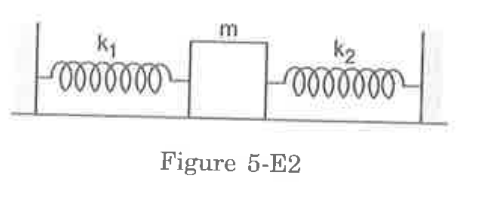
View SolutionA small block B is placed on another block A of mass 5 kg and length 20 cm. Initially, the block B is near the right end of block A. A constant horizontal force of 10 N is applied to the block A. All the surfaces are assumed frictionless. Find the time elapsed before the block B separates from A.
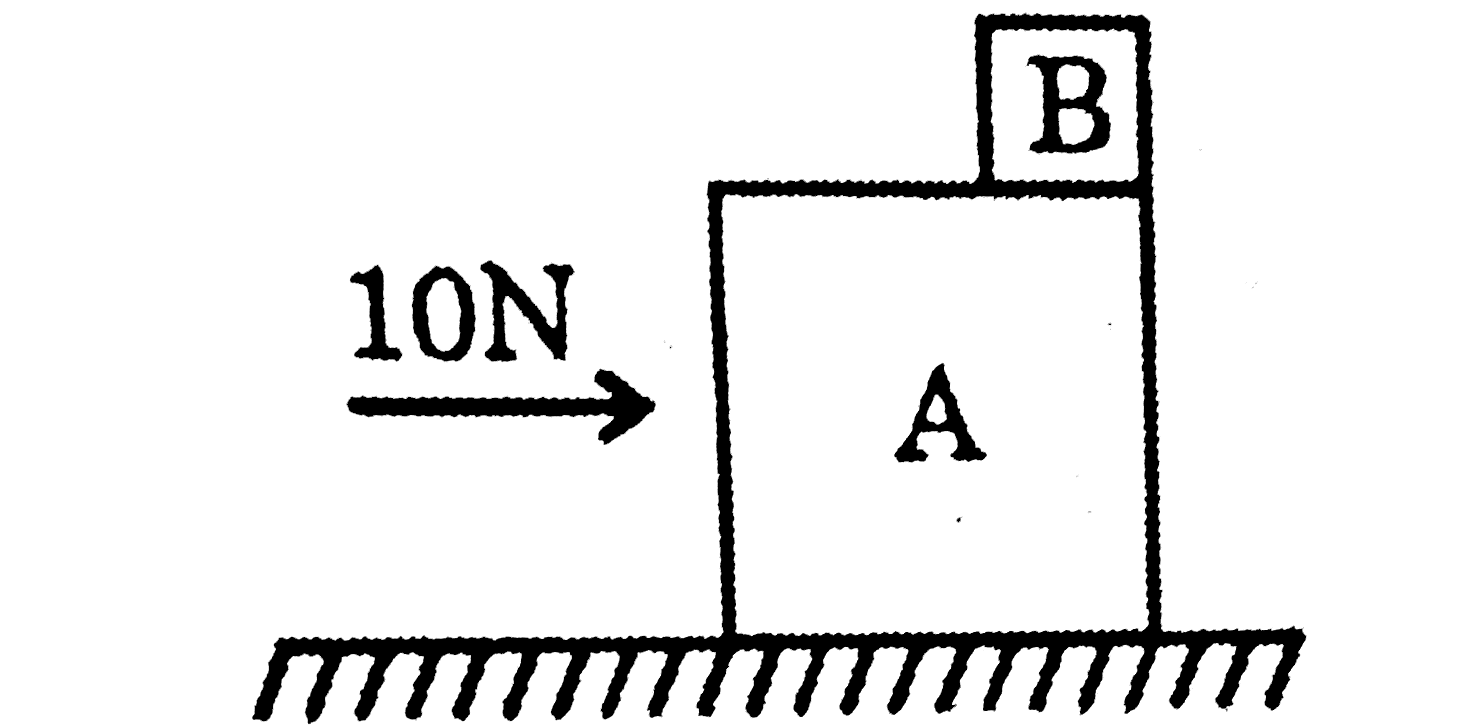
View SolutionA man has fallen into a ditch of width d and two of his friends are slowly pulling him out using a light rope and two fixed pulleys as shown in figure. Show that the force (assumed equal for both the friends) exerted by each friend on the road increases as the man moves up. Find the force when theman is at a depth h.
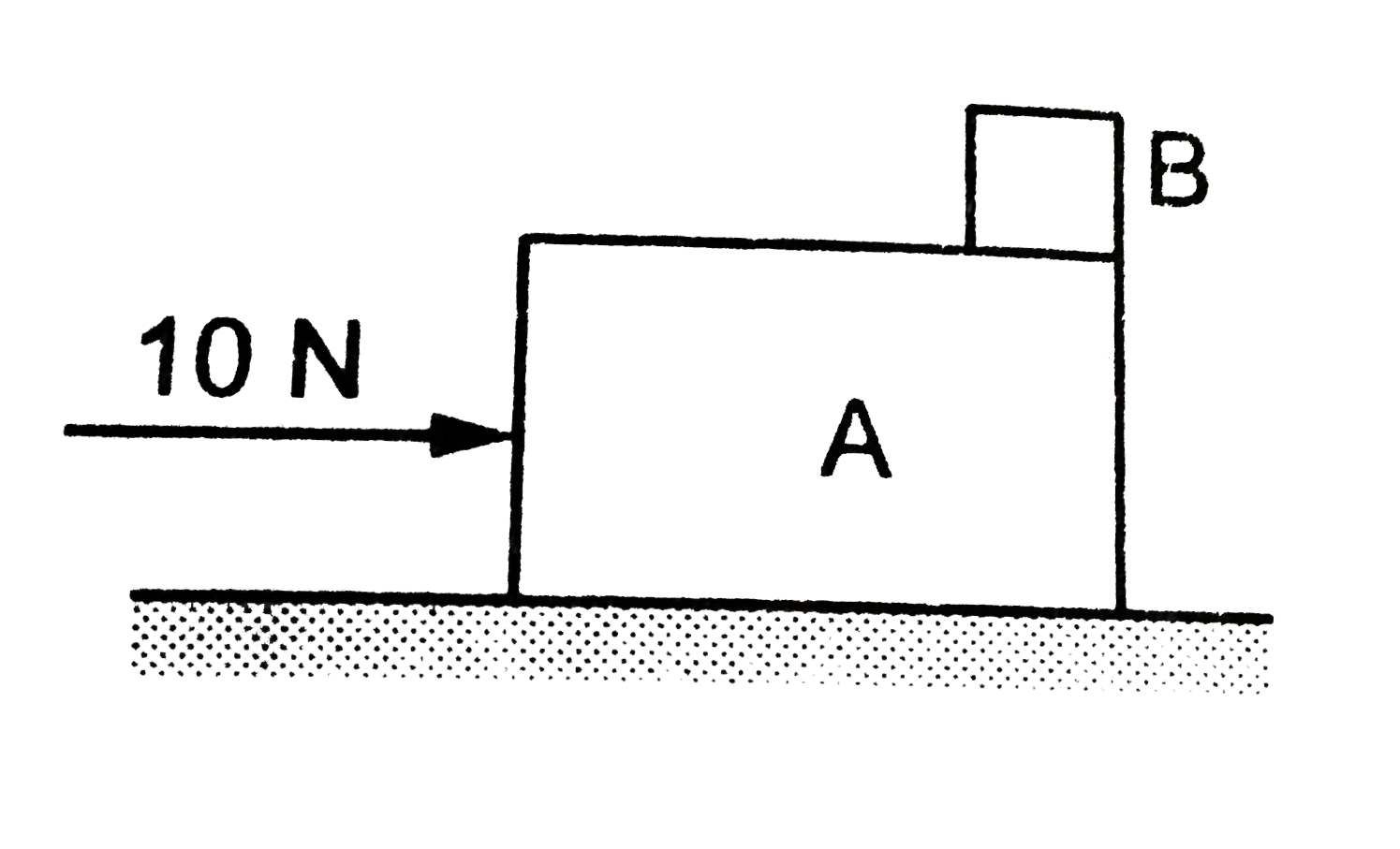
View SolutionThe elevator shown in figure is descending with an acceleration of `2m/s^2`. The mass of the block A is 0.5 kg. What force is exerted by the block A on the block B?

View SolutionA pendulum bobof masss 50 g is suspended from the ceiling of an elevator. Find the tension in the string if the elevator a. goes up with acceleration `1.2 m/s^2`, b. goes up with deceleration `1.2 m/s^2`, c. goes up with uniform velocity, d. goes down with acceleration `1.2 m/s^2` e. goes down with deceleration `1.2 m/s^2` and f. goes downwith uniform velocity.
View SolutionA perso is standing on a weighing machine placed on the floor of an elevator. The elevator starts going up with some acceleratiion, moves with uniform velocity for a while and finally decelerates to stop. The maximum and the minimum weights recorded are 72 kg and 60 kg. Assuming that the magnitudes of the acceleration and the decelaration are teh same., find a. the true weight of the person and b. the magnitude of the acceleration. Take `g=9.9 m/s^2`.

View SolutionFind the reading of th spring balance shown in figure. The elevator is going up with an accelertion of g/10, the pulley and the strng are light and the pulley is smooth.
View SolutionA block of 2 kg is suspended from the ceiling trhough a massless spring of spring constant k=100 N/m. What is the elongation of the spring? If another 1 kg is dded to the block, what would be the further eleongation?
View SolutionSuppose the ceiling in the previous problem is that the elevator which is going up with an acceleration of `2.0 m/s^2`. Find the elongations.
View SolutionThe force of buoyancy exerted by the atmosphere on a balloon is B in the upward direction and remains constant. The force of air resistance on the balloon acts opposite to the direction of velocity and is proportional to it. The balloon carries a mass M and is found to fall down near the earth's surface with a constant velocity v. How uch mass hsould be removed from teh balloon so that it may rise with a constant velocity v?
View SolutionAn empty plastic box of mass sm is found to accelerate up at the rate of g/6 when placed deep inside water. How much sand should be put inside the box so tht it may accelerate down at the rate of g/6?
View SolutionA force `vecF=vecvxxvecA` is exerted on a particle in addition to the force of gravity, where `vecv` is the veocity of the particle and `vecA` is a constant vector in the horizontal direction. With what minimum speed a particle of mass m be projected so that it continues to move undeflected with a constant velocity?
View SolutionIn a simple At wood machine, two unequal masses `m_1 and m_2` are connected by string going over a clamped light smooth pulley . IN a typical arrangement `m_1=300g` and `m_2=600g`. The system is released from rest. A. Find the distance travelled byi the first block in the first two seconds. b. Find the tension in the string. c. Findthe force exerted by the clamp on teh pulley.

View SolutionIn a simple Atwood machine, two unequal masses `m_1 and m_2` are connected by string going over a clamped light smooth pulley . In a typical arrangement `m_1=300g` and `m_2=600g`. The system is released from rest. (a). Find the distance traveled by the first block in the first two seconds. (b). Find the tension in the string. (c). Find the force exerted by the clamp on the pulley.

View SolutionFigure shwos a uniform rod of length 30 cm having a mass of 3.0 kg. The strings shownin the figure are pulled by constant forces of 20 N and 32N. Find the force exerted by the 20 cm part of the rod on the 10 cm part. All the surfaces are smoth and the strings and the pulleys are light.

View SolutionConsider the situation shown in figure. All the surfaces are frictions and the string and the pulley are light. Find the magnitude of the acceleration of the two blocks.
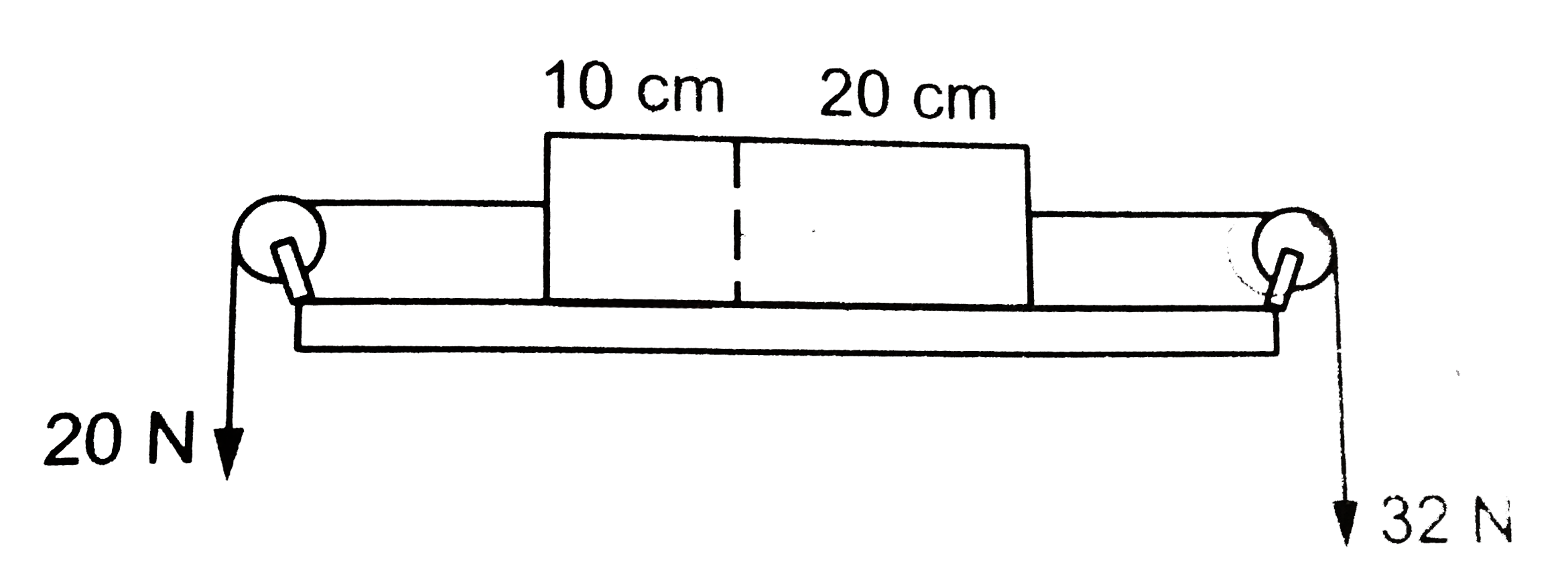
View SolutionA constant force F=m_2g/s` is applied on the block of mass `m_1` as shown in figure. The string and the pulley are light and the surface of the table is smooth. Find the acceleration of `m_1`
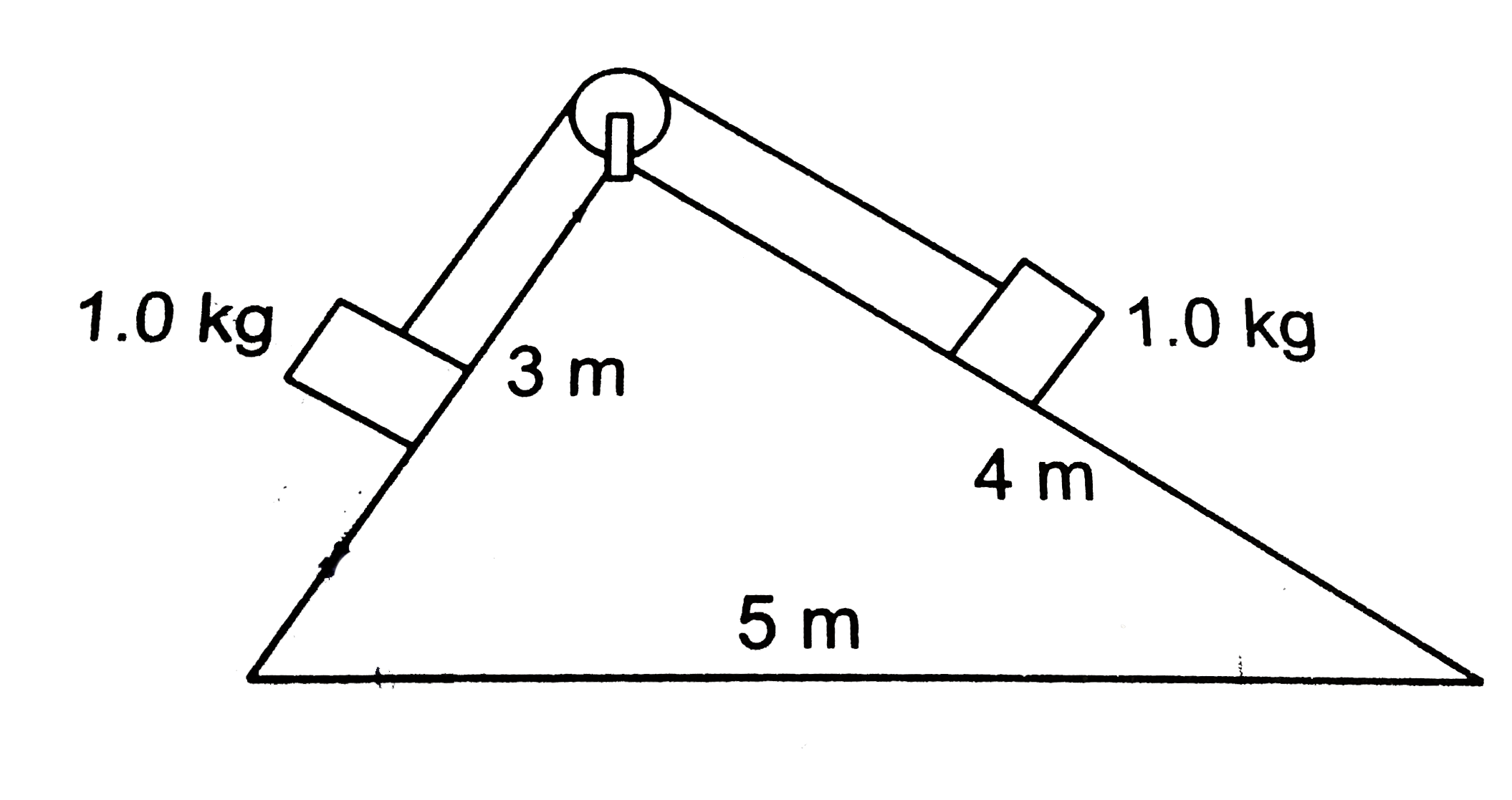
View SolutionIn figure `m_1=5 kg, m_2=2kg and F=1N.` Find the acceleration of either block. Describe the motion of `m_1` if th string breaks but F continues to act.

View SolutionLet `m_1=1 kg, m_2=2kg and m_3=3kg` is figure. Find the acceleration of `m_1, m_2 and m_3`. The string from the upper pulley to `m_1` is 20 cm when the system is realeased from rest. How ong will it take before `m_1` strikes the pulley?
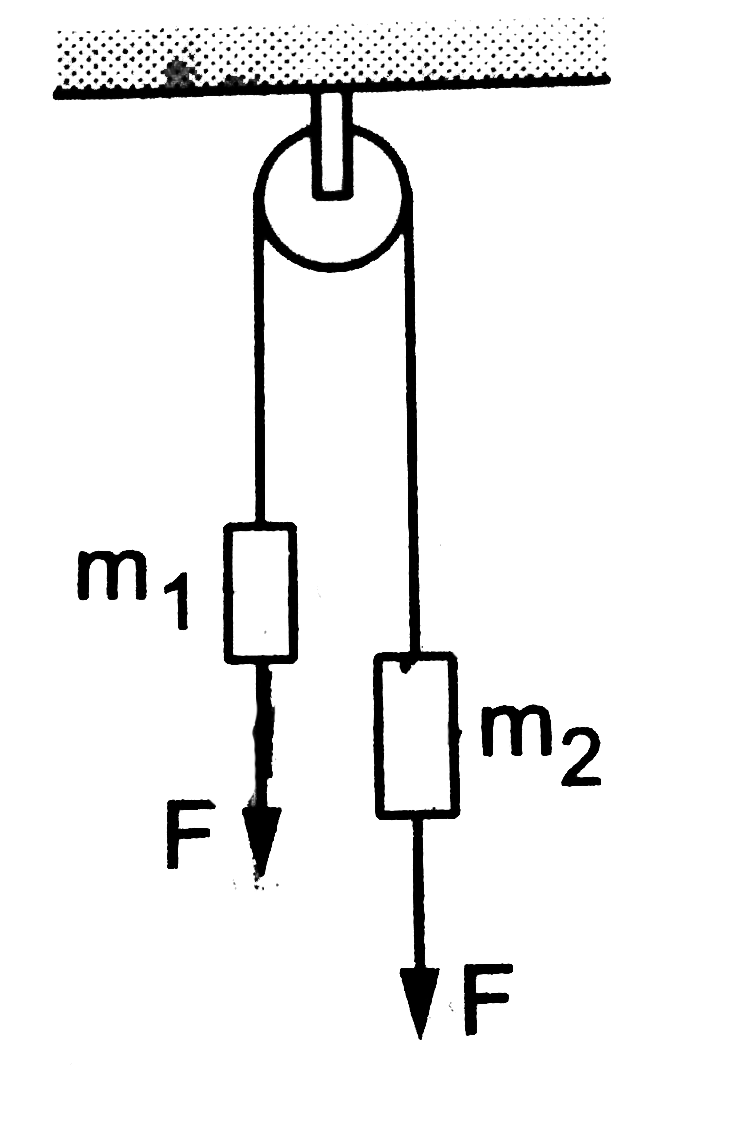
View SolutionIn the previous problem, suppose `m_2=2.0kg and m_3=3.0 kg`. What should be the mass m so that it remains at rest?
View SolutionCalculate the tension in the string shown in figure. The pulley and the string are light and all surfaces are frictionless. Take g=10 m/`s^2`.
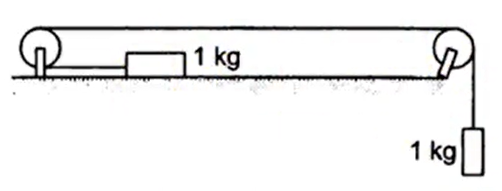
View SolutionConsider4 the situation shown in figure. Bothe the pulleys and the string are light and all the surfaces are friction less. a. Find the acceleration of the mass M. b. Find the tension in the string c. Calculate the force exerted by the clamp on the pulley A in the figure.

View Solutionfind the acceleration of the block of mass M in the situation shown in figure. All the surfaces are frictionless and the pulleys and the string are light.

View SolutionFind the mass M of the hanging block in figure which will prevent the smaller block from sliping over the triangular blcok. All the surfaces are frictions and the strings and the pulleys are light.
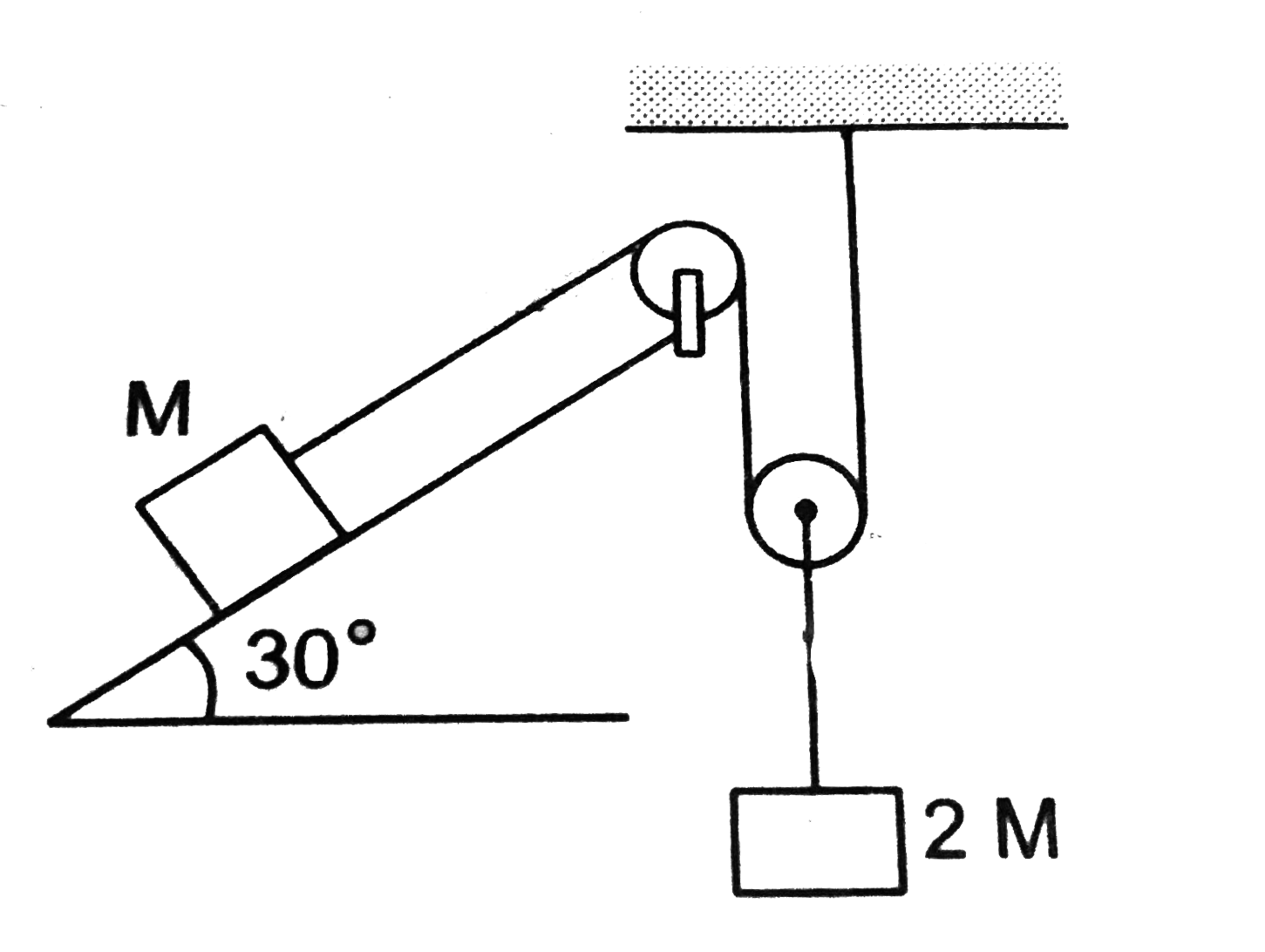
View SolutionFind the acceleration of the blocks A and B in the three situations shown in figure.
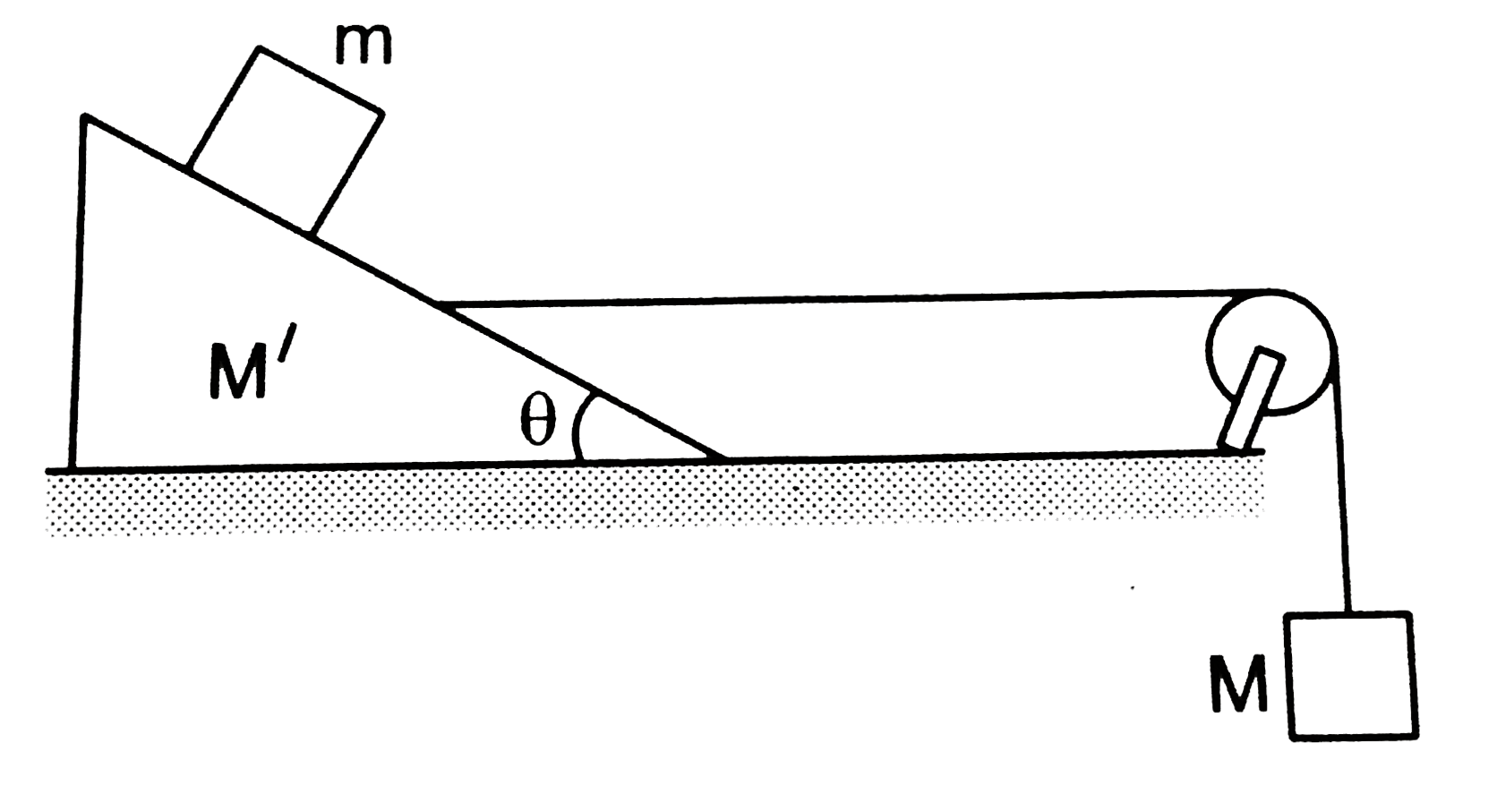
View SolutionFind the acceleration of the 500 g block in figure.
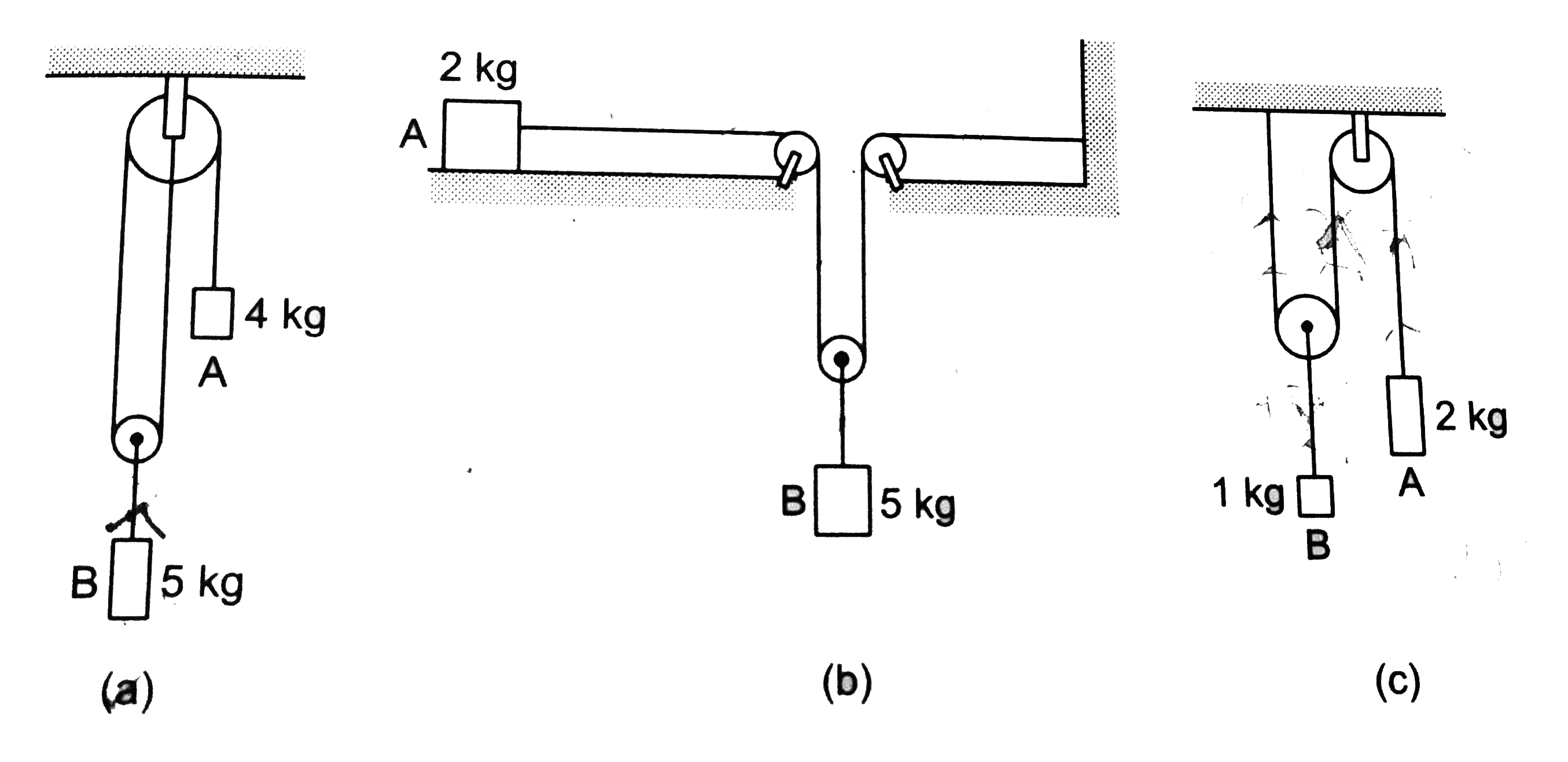
View SolutionA monkey a mass 15 kg is climbing on a rope with one end fixed to the ceiling. If it whishes to go up with an acceleration of `1 m/s^2`, how much force should it apply to the rope? If the rope is 5 m long and the monkey starts from rest, how much time will it take to reach the ceiling?
View SolutionA monkey is climbing on a rope that goes over a smooth light pulley and supports a block of equal mass at the other end. Show that whatever force the monkey exerts on the rope, the monkey and the block move in the same direction with
View Solutionequal acceleration. IF initially both were at rest, their separation will not change as time passes.
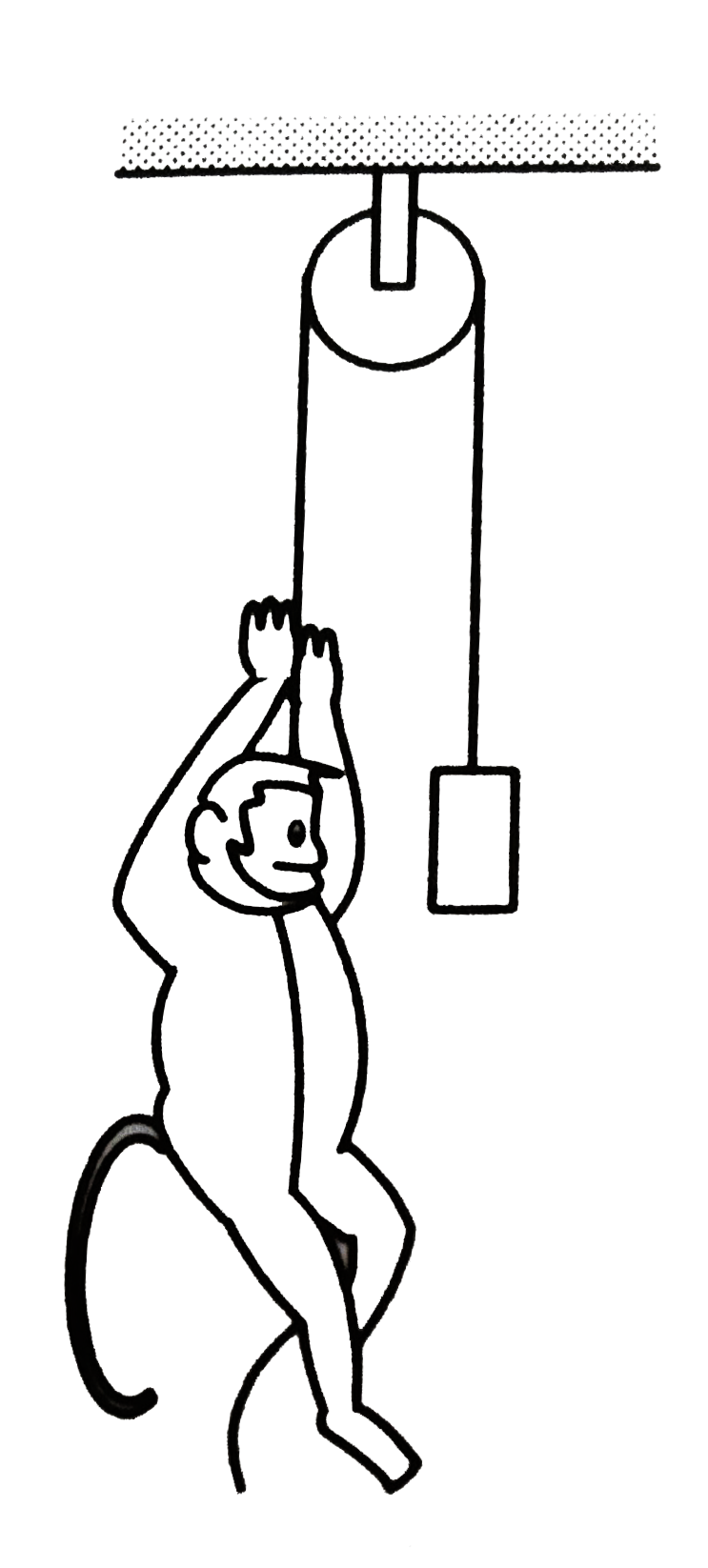
View SolutionThe monkey B shown in figure is holding on to the tall of the monkey A which is climbing up a rope. The masses of the monkeys A and B are 5 kg and 2kg respectively. If A can tolerate a tension of 30 N in its tail what force should it apply on the rope in order to carry the monkey B with it? Take `g=10 ,m/s^2`.
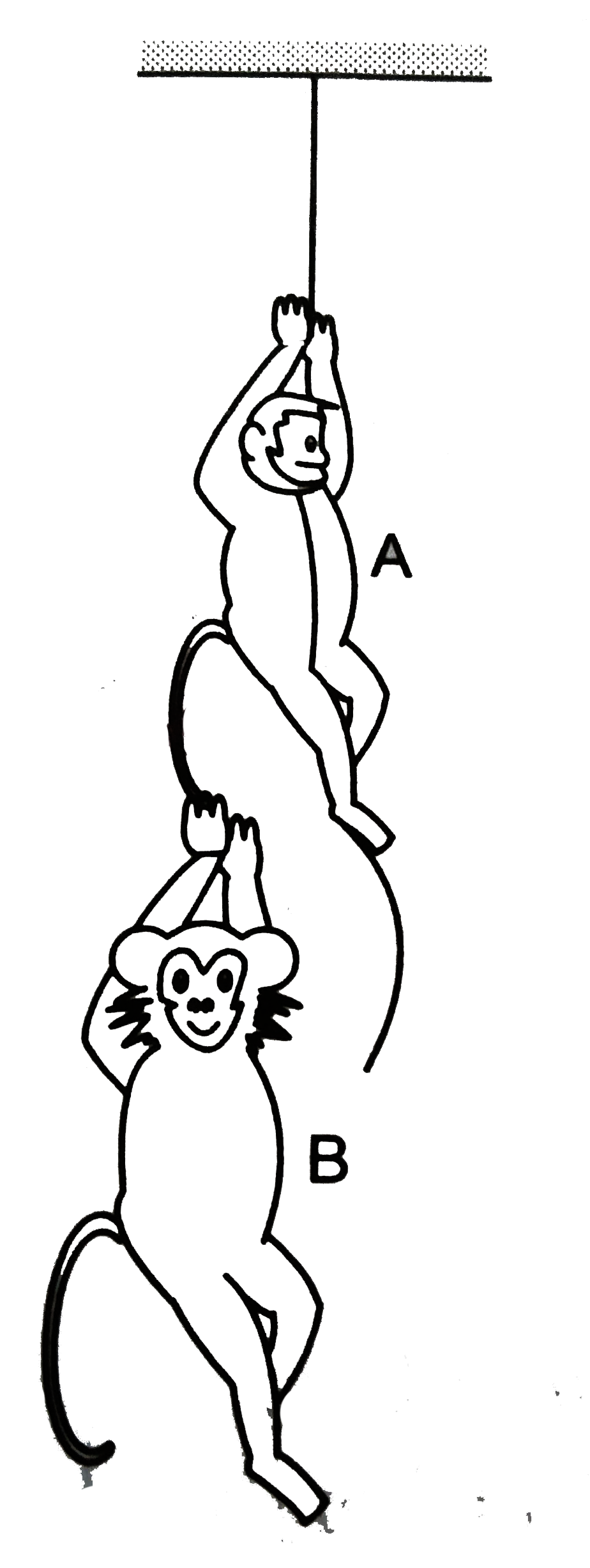
View SolutionFigure shows a man of mass 60 kg standing on a light weighting machine kept in a box of mass 30 kg. The box is haning from a pulley fixed to the ceiling through a light rope, the other end of which is held by the man himswelf. If the man manages to keepthe box at rest, what is the weight shown by the man manages to keep the box at rest, what is the weight shown by the machine? What force should he exert on the rope to get his correct weight on the machine?

View SolutionA blcok A can slidke on a frictionless incline of angle `theta` and length l, kept inside an elevator going up with unifor velocity v. Find the time taken by the block to slide down the length of the incline if it is released from the top of the incline.
View SolutionA car is speeding up on a horizontal road with anaccelerationa. Consider the following situations in the car. i. A ball is suspended from the ceiling through a string and is maintaining a constant angel with the vertical. Find this angle. Ii. A block is kept on a smooth incline and does not slip on the incline. Find the angle of the incline with a horizontal.
View Solutiona block is kept on the floor of an elevator at rest. The elevator starts descending with an acceleration of `12 m/s^2`. Find the displacement of the block during the first 0.2 s after the start. Take `g=10 m/s^2`.
View Solution
Exercises questions and complete solutions for chapter NEWTON'S LAWS OF MOTION of HC VERMA PHYSICS (HINGLISH) of Class 11